Couple introduces Berkeley falcons to the world, one post at a time
Reposted from the UC Berkeley News
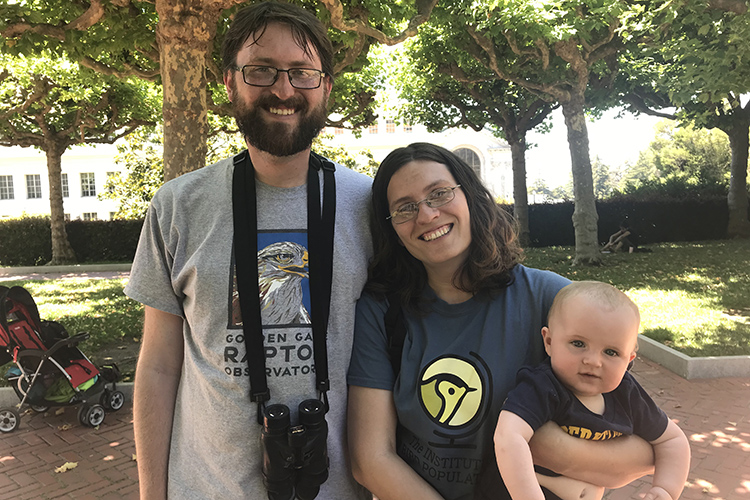
Berkeley Ph.D. student Sean Peterson and biologist Lynn Schofield — with their baby, Vireo Schofield-Peterson — find joy in sharing Berkeley's falcon family with the public. (UC Berkeley photo by Gretchen Kell)
UC Berkeley is globally famous for producing Nobel Prize-winning scientists, entrepreneurs, economists, artists and environmentalists. Now, a new group's got a spot — actually, a perch — on that list: peregrine falcons.
Falcons first hatched in a secluded nest atop the campus's 307-foot-tall Campanile in 2017, but not until Sean Peterson, a Berkeley Ph.D. student, and Lynn Schofield, a biologist in Marin County at the Institute for Bird Populations, began a social media project about them this year did Berkeley's raptor family achieve a following in more than 40 countries worldwide.
Two webcams installed on the bell tower in January made possible the pair's clever Cal Falcons Instagram, Facebook and Twitter posts, many of them about Carson and Cade — recent offspring of parents Annie and Grinnell. So far, viewers have watched the brothers appear, sport flight feathers, get banded, feast on fresh prey, practice flying and, recently, take wing.
The posts also have included falcon facts, short videos, close-up shots taken with long-focus lenses and fun Photoshopped images — from Carson and Cade in graduation regalia to Annie receiving a Mother's Day bouquet of pigeons — designed to prompt awe and appreciation for these once-endangered animals.
“Our number one mission always will be to prioritize conservation of peregrine falcons,” says Peterson. “But close behind that, we want to stoke people's interest in these amazing animals and a grow a community for them. And, we want to increase awareness of the wildlife in everyone's backyard.”
Peterson and Schofield, who are married, happily educate falcon fans who pose questions via social media with responses that are factual, friendly and, if necessary, reassuring. A popular one this spring was why a third egg laid by Annie, the mother falcon, didn't hatch.
The couple's efforts — and a live, May 6 Berkeleyside interview that included Vireo, their now 9-month-old son, who wears raptor booties — have resulted in the famlly occasionally being greeted by passersby as “the Peregrine Falcon People.”
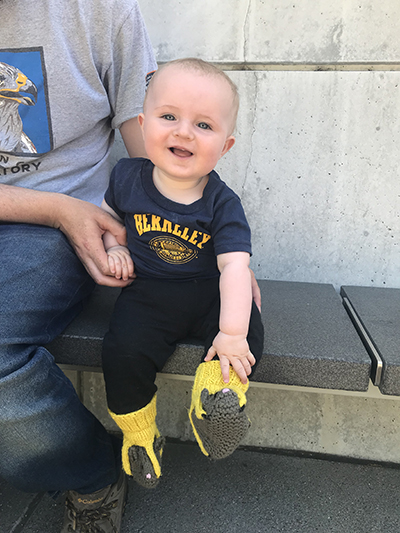
Vireo Schofield-Peterson, age 9 months, has raptor booties made by a family friend who volunteers with Vireo's parents at the Golden Gate Raptor Observatory. (UC Berkeley photo by Gretchen Kell)
“It tells me people are interested in the falcons,” says Peterson, of the family's nickname, “but I also think it's our baby they remember.”
Cal Falcons is a joint effort by seven bird experts who represent UC Berkeley, the Golden Gate Raptor Observatory, East Bay Regional Park District, Institute for Bird Populations and Institute for Wildlife Studies.
Observatory director Allen Fish says Peterson and Schofield “are both serious and focused ornithologists. And yet, they've been able to reach hundreds, maybe thousands, of Cal Falcons fans with their informal and spot-on social media posts and answers.
“This is a great lesson for scientists everywhere; we have many roads to teaching.”
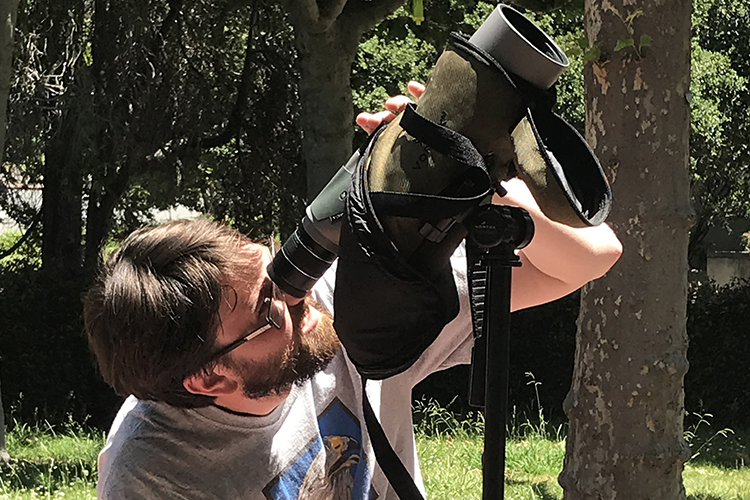
“Neither of us anticipated how much of a following there would be” for UC Berkeley's falcon family, says Ph.D. student Sean Peterson, who launched the social media project with his wife, Lynn, a biologist. This response followed a post showing a fluffy baby chick: “these birds are the only thing getting me through finals.” (UC Berkeley photo by Gretchen Kell)
A visibility problem
In winter 2016, Schofield, a biologist at the nonprofit Institute for Bird Populations, was working in the courtyard of Berkeley's Valley Life Sciences Building when she heard peregrine falcon cries. “I asked around if there was a pair on campus,” she says, “but everyone said no.”
Still, Schofield knew what she'd heard. She'd been familiar with falcons since her childhood in Minnesota, where she spent lunch hours watching a pair nesting on her dad's office building. Before moving to California, she also worked at the University of Minnesota's Raptor Center.
So, in early 2017, she and Peterson, along with Berkeley alumnus Doug Bell, the East Bay Regional Park District's wildlife program manager, and Mary Malec, a volunteer raptor nest monitor for the park district and Golden Gate Raptor Observatory, climbed high in the Campanile to look for falcons. The group soon was peeking through grates at a female falcon on a crude nest, on the western balcony above the tower's observation deck, “and she stared right back at us,” says Schofield.
“It's good we went up there,” she adds, “as the conditions weren't right. The balcony isn't quite level, Annie had laid four eggs — two had rolled away — and the birds were incubating the other two on a torn-open sand bag.”
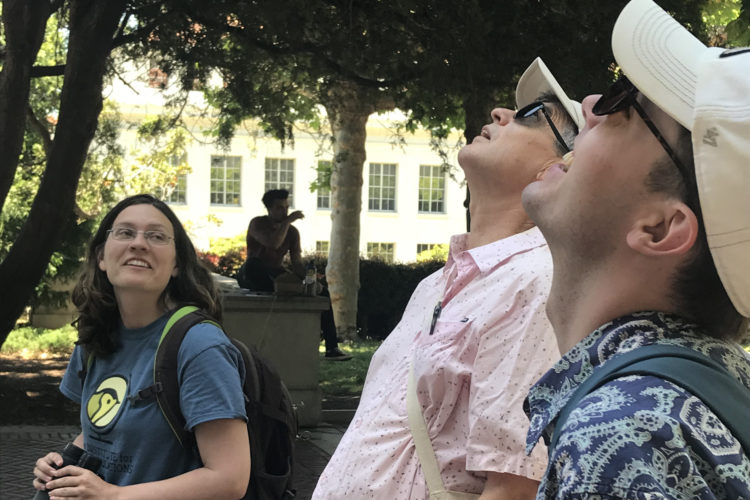
“It's a community thing,” Lynn Schofield (left) says of the peregrine falcon following that's been building since Annie and Grinnell first nested on the tower in 2017. (UC Berkeley photo by Gretchen Kell)
Emergency permission was obtained from state and federal authorities and UC Facilities Services to provide the falcon family with a temporary nest shelf — a large tray with gravel. Peterson and Schofield visited the tower almost every day, watching from below for evidence that the parents were feeding babies at the nest.
“At that point, our main worry was the nest itself, whether they'd have a successful nest, and if the chicks would fledge successfully,” says Peterson, whose dissertation in the Department of Environmental Policy, Science and Management is on wetland birds in the Sierra Nevada foothills.
In late May 2017, chicks Fiat and Lux emerged, and a volunteer falcon fledge watch crew assembled below the Campanile. It would monitor the young birds through spotting scopes as the siblings readied to fly and help them if they became stranded.

Cade begins to fly. “I'm surprised how proud I am of him,” a fan wrote in response to a Cal Falcons Instagram post. “go Cade go!!! wrote another. (Photo by John Davis)
Young Lux died that July after hitting a window, prompting a bird-proofing of windows around the tower. Yet, his parents, “because they'd had a successful nesting year,” says Peterson, persevered: The following year, three chicks — Berkelium, Californium and Lawrencium — were born on the Campanile, this time in a permanent, wooden box, and fledged successfully.
Still, it again was a struggle for Peterson and Schofield to view the nest. “We had no visibility up there, in the tower, and we didn't even know when the female had laid eggs,” says Schofield.
And, adds Peterson, “it was hard for people to experience the falcons from the ground.”
A fan club takes flight
“I think we were all thinking webcam from the beginning,” says Schofield, of the solution she and Peterson had for real-time observation of the birds on the tower. “There are a lot of great webcams for birds,” including one for a pair of bald eagles in Decorah, Iowa, and another for albatrosses in Kauai, Hawaii, that's currently on hiatus.
In October 2018, Berkeley launched a successful crowdfunding campaign for two 24/7 webcams, and last February, they were installed — one facing the nest, anotheron the northern balcony — in time for Cal Falcons and the public to observe a new and complete season of hatching and fledging.
As the chicks emerged, the nest webcam activity also was livestreamed on the Berkeley Art Museum and Pacific Film Archive's huge outdoor video screen. More than 500 people stopped by on April 25 to watch, and falcon experts were there to answer questions.
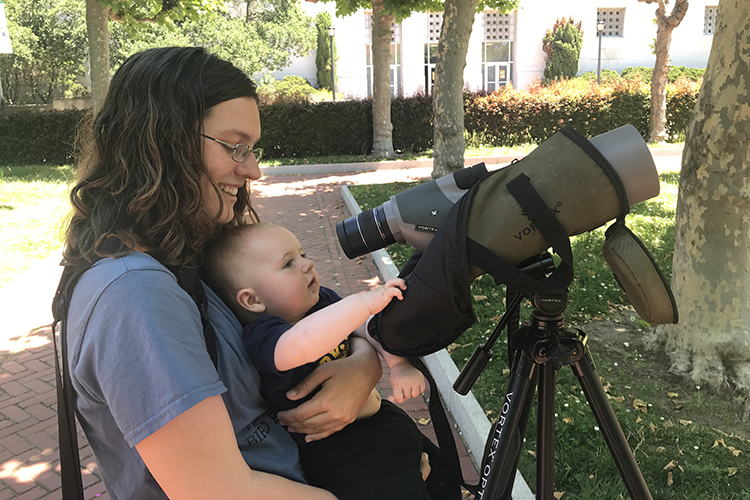
Lynn Schofield gets son Vireo acquainted with a telescopic lens, so he's ready someday for a close-up look at the falcons' every move atop the Campanile. (UC Berkeley photo by Gretchen Kell)
Peterson and Schofield say it's important that their Cal Falcons social media posts not only feature, but explain, the raptors' webcam activity.
“We know stuff will happen — birds die, sometimes— and we want to make sure there is a format where people are in communication with us, so we can help them understand natural history and realize they aren't watching pets,” says Schofield.
For example, when Carson and Cade fledged off the tower, with no branches nearby to land on and rest, says Peterson, “we never downplayed how dangerous that time period was. They could end up on the ground, and their flight muscles at first are not good enough for them to take off from there, and they become vulnerable to predators.”
Of Peterson and Schofield's posts, says Malec, “Their skill in answering questions is unsurpassed.”
The same could be said of their talent for sharing lighter moments, like the time aspiring hunters Cade and Carson caught a moth.
Cal Falcons fans live as far away as Japan, the United Kingdom and the Middle East, says Peterson, adding that neither he nor Schofield “anticipated how much of a following there would be for our posts, or the number of questions and cool opportunities to teach there would be.”
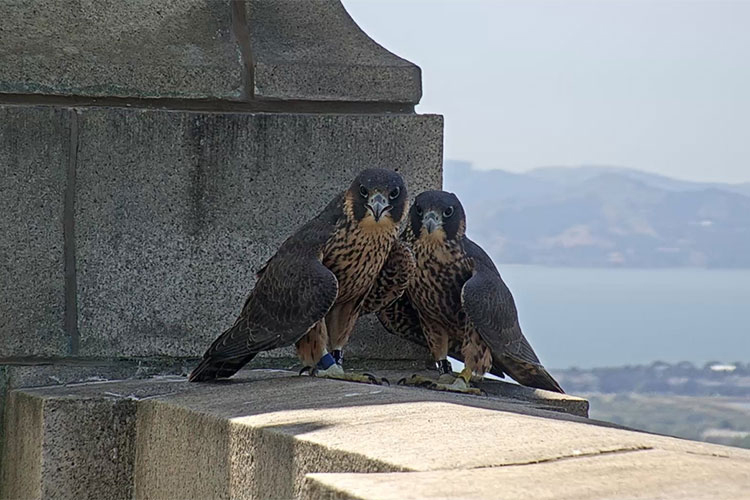
Falcon brothers Carson (left) and Cade, all grown up. Born April 24, 2019, they were named through a contest on the Cal Falcons Facebook fan page. (Photo courtesy of Cal Falcons)
He predicts that Carson and Cade will leave the Campanile in August, but says he and Schofield “will keep people up to date with any sightings we have … until breeding season picks up again.” Lawrencium, known as “Larry,” has been spotted on Alcatraz Island, and she is likely establishing a territory there, says Peterson, adding that a researcher doing seabird surveys there reported that Larry had killed a Canada goose mid-air for a meal.
Schofield says Cal Falcons' social media efforts so far have inspired one fan to take a bird behavior course, several teachers to involve their classrooms and children to submit names for the chicks — Fluffy and Peeppeep made it into this season's naming contest.
“We want the Cal Falcons audience to grow,” she says, “and it seems that caring about Berkeley's falcons is something everyone can agree on. If it's a sign of success, the president of the Berkeley College Republicans and the president of Cal Berkeley Democrats began following us on the same day.”
